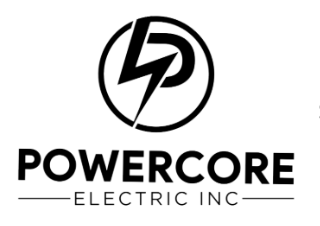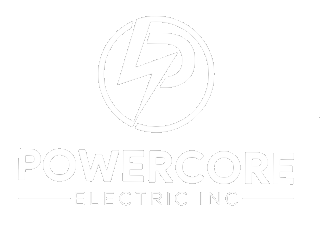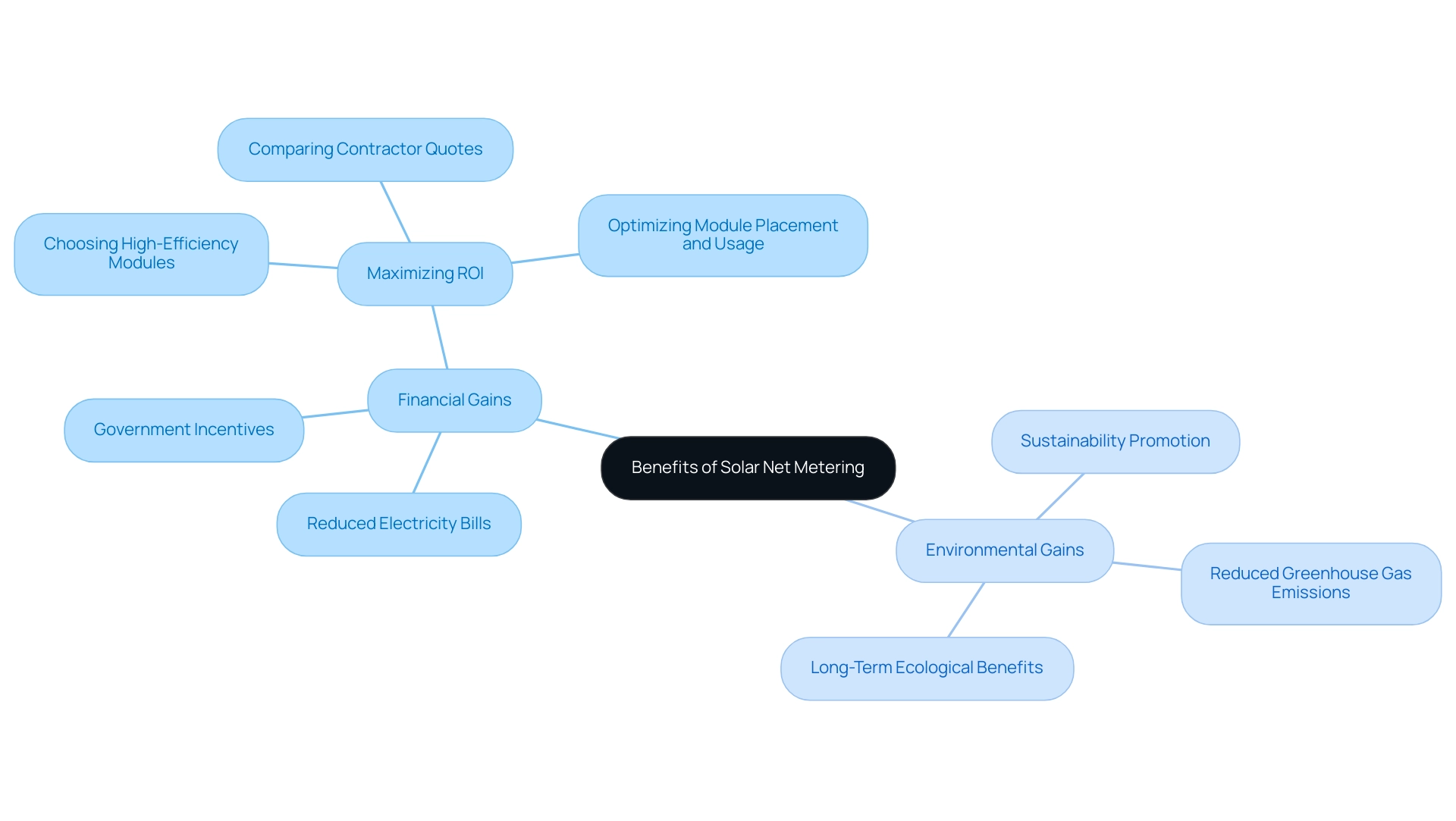Overview
Solar net metering is an advantageous billing system that allows homeowners to earn credits for excess electricity produced by their photovoltaic systems, effectively reducing their utility costs while promoting renewable energy use. The article highlights that this system not only fosters financial savings through reduced electricity bills but also contributes to environmental sustainability by incentivizing the adoption of solar energy, making it a compelling choice for eco-conscious homeowners.
Introduction
Navigating the world of solar energy can feel overwhelming, especially with the myriad of options and policies available to homeowners. Among these, net metering stands out as a game-changer, allowing individuals to reap the benefits of their solar panels while contributing to a sustainable future. This innovative billing system not only helps offset energy costs but also enables homeowners to earn credits for the excess electricity they generate.
With the rising popularity of solar power and advancements in technology, understanding how net metering works and its implications can empower homeowners to make informed decisions that enhance both their financial well-being and environmental impact.
Dive into this comprehensive overview to discover the mechanics of net metering, its benefits, and what the future holds for solar energy enthusiasts.
Understanding Net Metering: A Comprehensive Overview
The concept of explained reveals that it is an exceptionally advantageous billing system for homeowners who capture the power of sunlight. This system enables you to earn credits for any surplus electricity your photovoltaic units produce and return to the grid. Consider it as a means to improve your independence in power while promoting the wider use of renewable power sources.
Fundamentally, net metering balances your electricity consumption with the renewable power generated by your photovoltaic systems, resulting in considerable reductions on your utility expenses. For example, homeowners under the 200% Rule have reported significant decreases in their utility expenses by enhancing their photovoltaic systems. With the transformative impact of California’s building codes and NEM 3.0, the adoption of renewable energy has become more accessible and appealing.
Comprehending how to optimize photovoltaic system performance—such as identifying the best installation angle and dimension under the 200% Rule—can further increase these savings. Additionally, choosing the appropriate panel inverter is essential for ensuring your system operates efficiently. As utility-scale photovoltaic systems continue to thrive—projected to grow by 18% through 2026 according to the analyst team at Wood Mackenzie—the allure of this renewable source becomes even more pronounced.
In Q3 2024 alone, the utility-scale photovoltaic sector achieved its strongest performance on record with 6.6 GW installed, reflecting a remarkable 44% year-over-year growth. This robust growth highlights the effectiveness of solar net metering explained in promoting renewable resource adoption. With net metering, you’re not just making a smart financial choice; you’re also contributing to a cleaner, greener planet.
It’s truly a win-win situation for both your wallet and the environment.
How Solar Net Metering Works: Mechanics and Processes
When you set up photovoltaic systems, they generate power throughout the day, frequently creating more electricity than your house uses. This excess electricity is sent back to the grid, which is part of the process known as solar net metering explained, allowing your utility company to track it and credit your account. This credit system is essential; it enables you to balance future power expenses during periods when your systems aren’t producing sufficient electricity, like at night or on overcast days.
Usually, the credit you receive mirrors the retail rate of electricity, indicating the more power your panels produce, the bigger your savings on your utility bill. However, during peak sunlight production and low power demand periods, the worth of the electricity you send to the grid may be reduced, which can affect your overall savings. As of November 2023, the concept of solar net metering explained is active in 34 states and Washington, D.C., helping homeowners take advantage of these savings.
Furthermore, many homeowners exploring renewable energy investments consider financing options like home equity loans, HELOCs, and energy loans, usually with repayment periods ranging from two to seven years. According to Brian Lips, a Senior Policy Analyst at the NC Clean Energy Technology Center, the adoption of these policies has gradually increased, stating, ‘After that report, I expected to see an avalanche coming but it kind of happened slowly at first and has ramped up over time.’ This trend demonstrates a growing acknowledgment of the advantages of renewable energy for homeowners, further backed by real-world case studies on financing energy investments.
Additionally, homeowners can explore government programs designed to facilitate the adoption of renewable energy. To benefit from these programs, consider the following steps:
- Research available incentives in your state;
- Consult with local energy providers to understand eligibility;
- Complete any required applications to access funding.
Homeowners should also assess for power storage, such as lithium-ion batteries for their efficiency and longevity, and adhere to best practices for choosing inverters, ensuring compatibility with their systems to maximize power efficiency and sustainability.
The Benefits of Solar Net Metering: Financial and Environmental Gains
explained provides a remarkable chance for homeowners to not only reduce their bills but also contribute positively to the environment. By generating your own electricity through photovoltaic panels, you can significantly lessen your dependence on the grid, which may even lead to the complete elimination of your electricity bill. This is especially appealing given that access to backup power was a primary reason many homeowners opted for batteries in 2023, underscoring the desire for energy independence.
Furthermore, homeowners should consider the comprehensive insights available on renewable energy solutions, such as Tesla home chargers and various government programs that can assist in making the transition to renewable energy more accessible. For instance, programs that provide rebates or tax incentives can significantly lower the initial investment needed for photovoltaic installations. It’s important to be aware of fluctuations in net metering policies in states like Nevada, as these can impact the financial viability of renewable energy investments.
Property owners can enhance their return on investment from renewable resources by:
- Choosing high-efficiency modules
- Comparing contractor quotes
- Optimizing module placement and usage
This is emphasized in the case study titled ‘Tips to Maximize Renewable Resource ROI.’ Furthermore, findings from the case study ‘How Homeowners Benefited from Household Renewable Systems Under the 200% Rule’ illustrate how strategic planning can improve power savings and overall satisfaction with renewable investments. Regular maintenance, including panel cleaning services, is also crucial for ensuring optimal performance and longevity of energy systems.
The concept of solar net metering explained plays a crucial role in promoting sustainability by incentivizing the use of renewable power sources, ultimately leading to a reduction in greenhouse gas emissions. The Environmental Protection Agency offers a formula to determine how renewable practices, such as solar net metering explained, help in reducing carbon emissions and strengthening the ecological advantages of harnessing sunlight. As Ben Zientara, an experienced renewable policy analyst, highlights, adopting this form of power is not merely a financial choice; it’s a move towards a more sustainable future.
The interplay of financial savings and positive environmental impact makes renewable energy a compelling option for homeowners dedicated to both their budgets and the planet.
Current Trends and Future Outlook in Solar Net Metering
In recent years, explained through significant changes in policies shows how various states have revised their calculation of credits and introduced innovative compensation models. Understanding the concept of solar net metering explained is essential for homeowners, as it directly influences the savings you can attain with your power systems. Essentially, the concept of solar net metering explained credits renewable power users for the excess electricity they generate, meaning when your panels produce more power than you need, the surplus feeds back into the grid, earning you credits on your electric bill and effectively lowering your costs.
Moreover, exciting advancements in photovoltaic technology, like the development of lead-tin perovskite cells with an impressive efficiency of 23.2%, are revolutionizing how we harness sunlight. Recent case studies indicate that this advancement marks a considerable leap in cell technology. These innovations not only enhance power generation but also improve management through better battery storage solutions.
As the energy market continues to expand and evolve, staying informed about these trends is vital.
When evaluating service providers, it’s essential to consider how these advancements and the solar net metering explained policies, particularly NEM 3.0, affect their offerings. Understanding how solar net metering explained relates to NEM 3.0 is crucial, as it can significantly influence the compensation you receive for surplus power, making it important to compare providers based on their alignment with these new regulations and technologies. By comprehending the latest advancements in photovoltaic technology and understanding solar net metering explained, you can optimize the advantages of your investment and ensure you’re deriving the most from the power you produce, making your eco-conscious decisions even more valuable.
Net Metering vs. Other Compensation Models: What You Need to Know
While the concept of solar net metering explained is widely acknowledged as a compensation model for users of renewable sources, it’s important for eco-conscious homeowners to know that other options, such as net billing, also exist. Under net billing, homeowners receive a lower rate for the surplus power they send back to the grid, which can significantly influence overall savings. In 2023, several states revised their net metering policies, as highlighted in the case study titled ‘Future of Net Metering in the U.S.,’ which includes insights on solar net metering explained, prompting many homeowners to evaluate their options sooner than expected.
According to Ben Zientara, a policy analyst, ‘Understanding the nuances of compensation models is crucial for homeowners as policy changes can greatly impact their investments in renewable energy.’ This underscores the need for you to stay informed about how these compensation models can affect your financial decisions. By understanding the differences between solar net metering explained and net billing, you can make a more informed decision that is tailored to your power needs and financial goals.
Furthermore, when evaluating the expenses, generally falls between $500 and $700 for the device alone, not including installation charges, whereas installations of photovoltaic systems can fluctuate significantly from $15,000 to $25,000 based on the system dimensions and regional incentives. Grasping the expenses linked to these installations, along with the possible savings on electricity bills, can improve your efficiency and contribute to a greener future. Furthermore, exploring government solar programs can provide financial assistance, and utilizing professional cleaning services for solar panels can ensure optimal performance, maximizing your investment in renewable energy.
Conclusion
The journey into solar energy and net metering reveals an incredible opportunity for homeowners to not only save money but also contribute to a cleaner environment. By understanding how net metering works, individuals can effectively offset their energy costs and earn credits for the surplus electricity produced by their solar panels. This system not only fosters energy independence but also encourages the broader adoption of renewable energy sources, making it a win-win for both personal finances and the planet.
As net metering policies evolve and technology advances, staying informed is crucial. Homeowners can maximize their solar investments by:
- Selecting high-quality solar panels
- Understanding the nuances of compensation models
- Keeping abreast of local incentives and programs
From optimizing installation angles to exploring financing options, each step taken can lead to significant financial and environmental benefits.
Looking ahead, the future of solar energy appears bright. With innovations in solar technology and the continued growth of net metering policies, homeowners are empowered to make choices that align with their financial goals while supporting a sustainable future. Embracing solar energy is more than just a smart financial decision; it’s a commitment to a greener world for generations to come.



